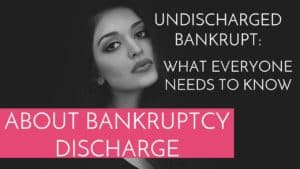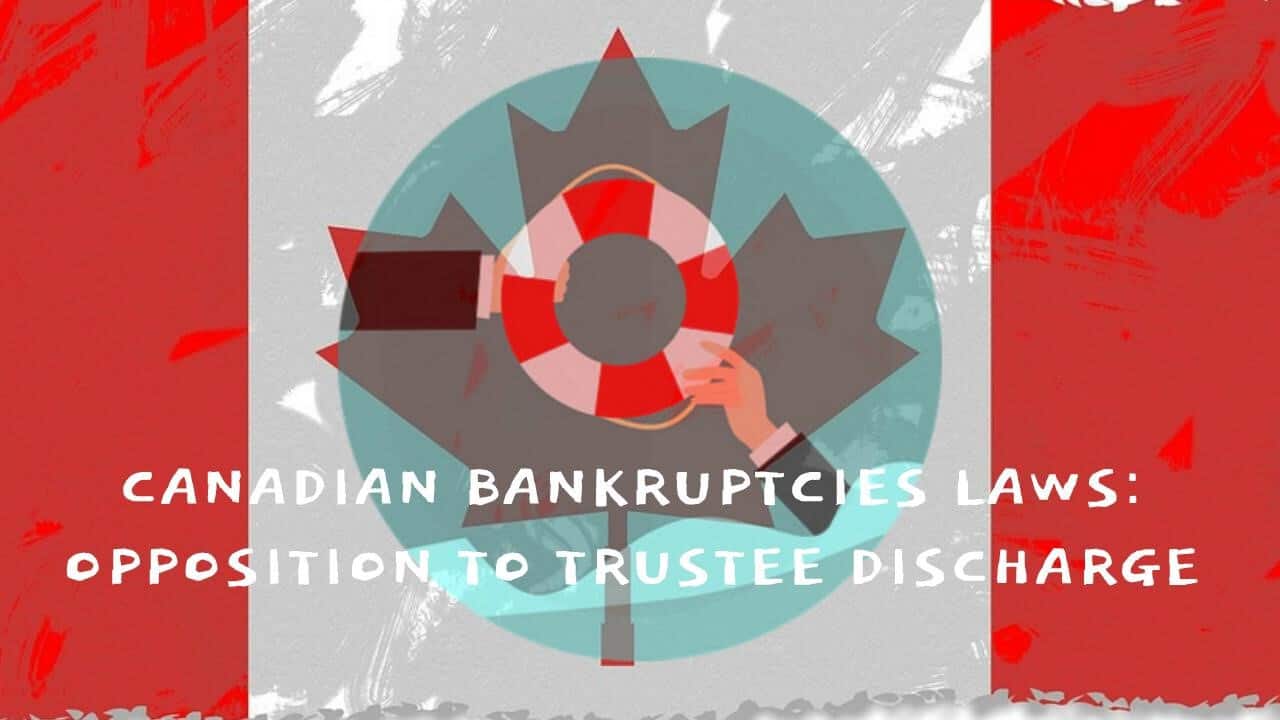
If you would prefer to hear an audio version of this undischarged bankrupt Brandon’s Blog, please scroll down to the bottom and click on the podcast
Undischarged bankrupt introduction
I recently read a Manitoba court decision issued in late October about the position taken by a judgment creditor in an undischarged bankrupt’s hearing. The creditor holding the judgment realized that the bankrupt’s discharge would discharge that debt. So, they tried to convince the court that their debt fit into one of the limited classes of debt that is not discharged by the bankrupt discharge.
That court case reminded me that is not so unusual. Many times a creditor who holds a judgment against the undischarged bankrupt tries to bootstrap their position. One of the leading cases cited by the Manitoba court is a 2018 decision from the Court of Appeal for Ontario.
The purpose of this Brandon’s Blog is to describe the bankruptcy discharge process, the position taken by the judgment creditor and what the Court has to say about that.
How bankruptcies work in Canada
The Canadian bankruptcy legislation is open for an insolvent and not viable company, or the insolvent, honest but unfortunate person can obtain relief. Subject to trust claimants’ rights and secured creditors, the company or person is assigning all of their unencumbered assets to the licensed insolvency trustee (formerly called a bankruptcy trustee) (Trustee). In return, the bankrupt person can have all of their debts discharged, subject to certain exceptions.
The bankruptcy discharge is amongst the primary advantages of relief under the Bankruptcy and Insolvency Act (Canada) (BIA). The discharge is vital to the bankruptcy procedure. Debtors, after bankruptcy, can wipe the slate tidy as well as begin over. This is a central concept under the BIA law. That is the essence of the bankruptcy discharge meaning.
A bankruptcy discharge is when the bankrupt is released under Canadian bankruptcy law from his or her financial debts as part of the bankruptcy discharge procedure. Some people think that it is the declaring for bankruptcy that releases the insolvent from obligation. This is not the case, it is the discharge that releases a bankrupt from debt.
A bankruptcy discharge provides the discharge of all unsecured debts, except for:
- support payments to a previous partner or children;
- penalties or fines enforced by the Court;
- financial debts arising from fraud or fraudulent breach of trust;
- student loans if less than seven years have actually passed since the bankrupt stopped being a part-time or full-time student.
Can an undischarged bankrupt leave the country?
If you are an undischarged bankrupt, you can travel. There are no restrictions on you leaving or returning to Canada if you are travelling for work or on vacation. Just make sure that your travel plans do not interfere with your legal obligation and your duties in your personal bankruptcy case, including:
- attending a meeting of creditors (if one is required);
- showing up for your mandatory counselling sessions;
- submitting your monthly income reports to the Trustee;
- remitting any surplus income payments you are required to make;
- providing your financial information to the Trustee so that your pre and post-bankruptcy income tax returns can be filed;
- being able to respond to any inquiries from your Trustee; and
- attending in Court for your bankruptcy discharge hearing in an opposed discharge application.
Undischarged bankrupt: What is an undischarged debt?
When a bankrupt is discharged from bankruptcy, the individual is released from the legal obligation to repay their different types of debt that is unsecured and existed on the day that the bankruptcy was filed, except for the following types of original debt:
- Alimony or support payments to a previous spouse or for the children;
- Fines or monetary penalties imposed by the Court;
- Financial obligations arising from fraud, misappropriation or defalcation; or
- Student loans if less than seven years have actually passed since the person stopped being a full or part-time student.
So other than for the small category of debts that are not discharged, once the bankrupt is discharged from their bankruptcy, they do not have to make payments on debts that existed at the date of bankruptcy.
Undischarged bankrupt: Trustee opposed the discharge
A first-time bankrupt, who does not need to pay surplus income, is entitled to an automatic discharge after 9 months. This assumes that they have lived up to all of their obligations as an undischarged bankrupt and fully cooperated with the LIT. If this first-time bankrupt is subject to surplus income, then they must pay it for 21 months before they are entitled to a discharge. Longer timelines apply for a second or more time bankrupt.
If the Trustee has evidence that the bankrupt has not been forthright and fully cooperative, or has actually committed one or more bankruptcy offences, then the Trustee has a duty to oppose the bankrupt’s discharge.
Notice of opposition to discharge
Similarly, any unsecured creditor can oppose the bankrupt’s discharge. The grounds of opposition would likewise be evidence of lack of honesty or that one or more offences have been committed. The process for a creditor opposing the discharge of the bankrupt is by filing a notice of opposition to discharge.
In either a Trustee or creditor opposed discharge, the bankrupt’s application for discharge must be heard in Bankruptcy Court. For more on the discharge process, you can read about it in one of my previous Brandon’s Blogs.

The judgement creditor
Often, a judgment creditor thinks they have a higher position in the pecking order than other unsecured creditors because they have a judgment. They may have even registered the judgement against the title to real estate owned wholly or partially by the defendant. Unfortunately, upon the bankruptcy of a person, all enforcement proceedings on a judgment must stop.
The judgment for a debt, in bankruptcy, is merely a piece of paper that proves you have unsecured debt. Nothing else. Anyone who understands the litigation process knows that there is a big difference between getting a judgment and collecting on it.
Judgement creditors may take a keener interest in the bankruptcy proceedings, including opposing the discharge from bankruptcy. The reasons for this are twofold:
- The judgment creditor has already spent time in court, money on legal fees and still has not collected their debt, so they are more invested in this person’s bankruptcy than someone who did not go the court route.
- They are hoping that they can somehow fit their money judgment only into a position where they can claim that the debt is one not released by an order of discharge.
It is this second reason that this Manitoba court case, and the Court of Appeal for Ontario decision relied upon by the Manitoba court, revolves around.
Undischarged bankrupt: Can more evidence be introduced by a judgment creditor at the discharge hearing?
Most judgements that I see in a debt settlement program under the BIA or bankruptcy tend to fall into the same category. A service or good was supplied and not paid for. A contract was entered into and was breached. That is just normal business. There is no fraud, embezzlement, misappropriation, defalcation, fraudulent misrepresentation or fraudulent breach of trust.
It is simply someone owes money and didn’t pay. The plaintiff entered all of the evidence they thought was important, the defendant either defended or allowed for default judgment to be obtained because they did not defend. Regardless, the court ordered the defendant to pay the money.
The judgement creditor was unpaid and then one day received the Trustee’s notice of bankruptcy in the mail. The judgment creditor was incensed. The creditor took an active interest in the bankruptcy proceedings and maybe even served as a bankruptcy inspector. The bankrupt person is now entitled to apply for his or her discharge from bankruptcy.
The judgment creditor is unhappy because they now know that they are receiving either nothing or a small dividend from the Trustee compared to the debt to be written off. So they now oppose the bankrupt’s discharge and try to get new evidence submitted to the Bankruptcy Court to somehow prove that their judgment is a claim that is not extinguished by the person’s bankruptcy discharge.
This is what the Court of Appeal decision was all about. Can you introduce new evidence at a bankruptcy discharge hearing?
The case I am referring to, Lawyers’ Professional Indemnity Company v. Rodriguez, 2018 ONCA 171 (CanLII). The appeals court said that the answer is no. You can read the entire decision here if you like. The Court of Appeal essentially said that the Court is allowed to look at:
- the judgment
- the proof that would certainly have been entered as evidence at the time in the pleadings
- as well as that evidence which has been led in the bankruptcy discharge hearing
to analyze whether the judgment debt falls within an exclusion to the general discharge rules. The Court also said that in a bankruptcy discharge hearing, the application judge was limited to looking at the judgment, the pleadings, the statement of claim and any statement of defence, to determine whether the judgment fell into the class of those debts not released by a discharge from bankruptcy. New evidence is not allowed.
This finding has been followed and further clarified. It is now apparent that the only purpose of a bankrupt’s application for discharge is to consider the bankrupt’s application. It is not a forum to attempt to advance new or amended claims.

Undischarged bankrupt summary
I hope you enjoyed this Brandon’s Blog on the undischarged bankrupt. Are you in need of financial restructuring? The financial restructuring process is complex. The Ira Smith Team understands how to do a complex restructuring. However, more importantly, we understand the needs of the entrepreneur or the person who has too much personal debt. You are worried because you are facing significant financial challenges.
It is not your fault that you are in this situation. You have been only shown the old ways that do not work anymore. The Ira Smith Team uses new modern ways to get you out of your debt troubles while avoiding bankruptcy. We can get you debt relief freedom.
The stress placed upon you is huge. We understand your pain points. We look at your entire situation and devise a strategy that is as unique as you and your problems; financial and emotional. We know that we can help you the way we take the load off of your shoulders and devise a debt settlement plan.
We know that people facing financial problems need a realistic lifeline. There is no “one solution fits all” approach with the Ira Smith Team. That is why we can develop a restructuring process as unique as the financial problems and pain you are facing. If any of this sounds familiar to you and you are serious about finding a solution, contact the Ira Smith Trustee & Receiver Inc. team today.
Call us now for a free consultation. We will get you or your company back on the road to healthy stress-free operations and recover from the pain points in your life, Starting Over, Starting Now.
undischarged bankrupt

